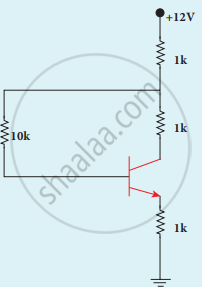Advertisements
Advertisements
प्रश्न
In a BJT, the largest current flow occurs ______.
विकल्प
In the emitter
In the collector
In the base
Through CB junction
उत्तर
In a BJT, the largest current flow occurs in the emitter.
Explanation:
Emitter is a thick, heavily doped layer. This supplies a large number of majority carriers for the current flow through the transistor
APPEARS IN
संबंधित प्रश्न
Derive the relation between α and β.
For a transistor β =75 and IE = 7.5 mA. The value of α is ______
Draw the circuit symbol of the PNP transistor.
With the help of a neat circuit diagram, explain the transistor as an amplifier?
Explain the current flow in an NPN transistor.
Sketch the static characteristics of a common emitter transistor and bring out the essential features of input and output characteristics.
Transistor functions as a switch. Explain.
Describe the function of a transistor as an amplifier with the neat circuit diagram. Sketch the input and output wave forms.
A transistor of α = 0.99 and VBE = 0.7 V is connected in the common-emitter configuration as shown in the figure. If the transistor is in the saturation region, find the value of collector current.

If l1, l2, l3 are the lengths of the emitter, base and collector of a transistor, then ____________.
In the symbol for a transistor, the arrow head points in the direction of the ____________.
In an npn transistor, the base current is 100 µA and the collector current is 10 mA. The emitter current is ______.
In an npn transistor, the collector current is 24 mA. If 80% of electrons reach collector, its base current in mA is ______.
In a transistor in CE configuration, the ratio of power gain to voltage gain is ____________.
In switching circuit, transistor is in ON state, values of IE and lB are 10 mA and 0.8 mA respectively and RL is 2 k`Omega`. If VCE is 7.6 V, then VCC is ____________.
In case of npn transistors, the collector current is always less than the emitter current because ______.
In a transistor, a change of 8.0 mA in the emitter current produces a change of 7.8 mA in the collector current. Then change in the base current is ____________.
The current gain `alpha` of a transistor is 0.95. The change in collector current corresponding to a change of 0.4 mA in the base current in a common emitter arrangement is ______.
In a transistor, the thickness of the base region ____________.
In transistor amplifier, base-emitter junction is forward biased and collector emitter junction is reverse biased. The current gain is ______.
In common emitter amplifier, a change of 0.2 mA in the base current causes a change of 5 mA in the collector current. If input resistance is 2K `Omega` and voltage gain is 75, the load resistance used in the circuit is ______.
In a study of transistor as an amplifier, the ratio of collector current to emitter current is 0.98. The collector current is 3mA, then base current will be approximately ______.
A common emitter amplifier has a voltage gain of 50, an input impedance of 100Ω and an output impedance of 2000Ω. The power gain of the amplifier is ______.
A conducting wire has length 'L1' and diameter 'd1'. After stretching the same wire length becomes 'L2' and diameter 'd2' The ratio of resistances before and after stretching is ______.
The reverse bias in a junction diode is changed from 8V to 13V, then the value of the current changes from 40μA to 60μA. The resistance of junction diode will be ______.
The collector current in a common-emitter transistor amplifier is 4 mA. When the base current is increased by 20 µA, the collector current increases to 6 mA. The current gain is ______.
Define peak value of alternating signal.
Define β
